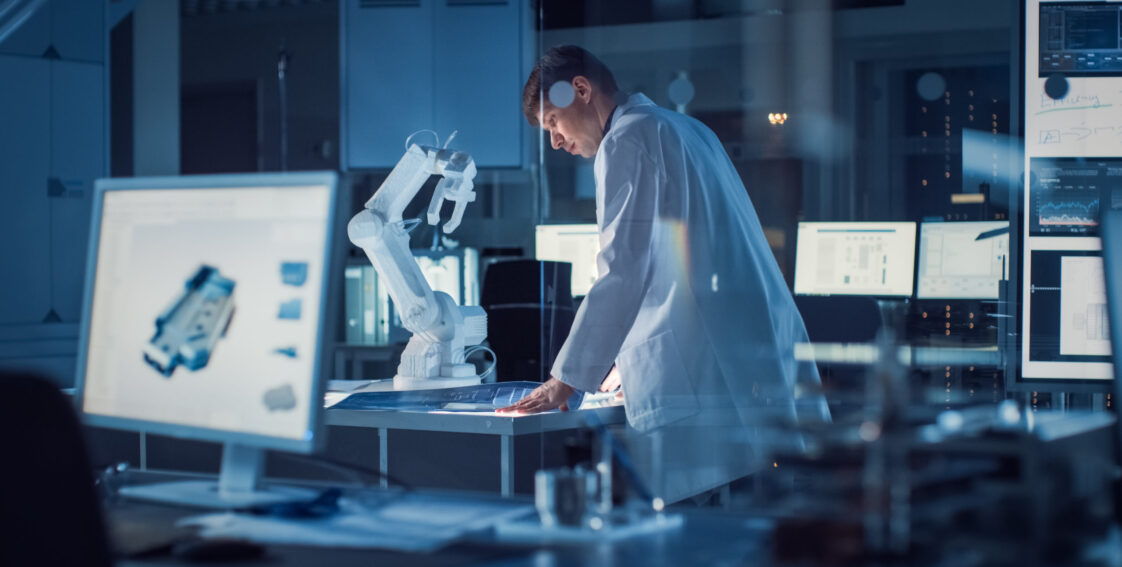
Your choice of robot affects the quality, speed and, versatility of your manufacturing process. Explore the key features of a 6 axis robot, SCARA robot, and a Cartesian robot to determine the best option for your facility. Automate your facility the right way with highly productive industrial automation.
What Is a 6 Axis Robot?
A 6 axis robot is the type most associated with industrial automation. This robot uses an articulated arm to bend, twist and position the tooling in various ways to accomplish a task of automation. The number of axes describes the servo controlled joints of the arm, so a 6 axis design allows this robotic arm to bend or twist six different ways allowing maximum articulating capability.
This style of industrial robot is highly flexible and offer significant reach and payload capability. If you have welding, cutting, machine loading, assembly or material handling that needs to be performed at various angles all around a workpiece or covering a radial work area, then this may be the right style for you. If your production needs require very high speeds and/or high accuracies, or long travel distances however, it isn’t usually as fast or accurate as other robot types or automation options.
Applications of a 6 Axis Robot
Choose a 6 axis robot for assembly, welding, machine tending or palletizing and material handling applications. These robots are commonly used in the automotive industry as well as many other manufacturing industries, where the flexible arm can reach all the necessary programmed points used to assemble automotive components and other manufacturing processes.
What Is a SCARA Robot?
High speed and high accuracy manufacturing requires a different style of automation. SCARA, or Selective Compliant Assembly Robot Arm, devices offer the speed and precision you need. These robots excel at fast, rigid and repeatable movements.
SCARA Robot arms typically will have 4 axis and are most often limited in payload to under 20kg and less than 1 meter of reach. This reduced flexibility and reach when compared to 6 axis robots can make applications difficult when the automated processes require large areas and complex multi-axis motions.
Applications of a SCARA Robot
These robots are typically used to rapidly assemble small components or high speed part handling in automation. They can be found in cell phone and watch manufacturing facilities. They can also be used with processes such as dispense adhesives, grease or applying gasket materials to components. It is also common to see robot guided vision used with SCARA Robots in applications where the part locations are random and need to be located using an integrated camera and software rather than programmed . Its even possible to locate and pick up a part moving on a conveyor belt if moving at a constant speed.
What Is a Cartesian Robot?
Multiple linear servo actuators mounted together to move in different planes simultaneously are known as Cartesian or Gantry types of robots . Servo motors position the tooling or move a pallet around to allow Cartesian robots to grip, cut, dispense or perform other processes in a rectangular work envelope. These robots can be smaller high speed, high accuracy versions like you would use in electronics assembly or very large area overhead versions known as Gantry robots. The larger gantry robots are unique in that they usually will have rack and pinion gear driven transmissions with significant rail load bearing capability for long distances traveled carrying heavy loads.
Cartesian and Gantry robots typically only have two three axis of movement capabilities. This makes them less flexible than both 6 axis and SCARA robots.
Applications of a Cartesian Robot
Consider a Cartesian or Gantry robot if you need to perform manufacturing processes in a rectangular work area and are using the robot to automate a process, perform material handling or machine loading and unloading. These robots have the highest load over long distance capacity, so they can easily haul and stack boxes and heavy materials around a large area.
How To Choose a Robot
It’s important to consider your automation application as well as the key feature and specifications of each robot type. All three robot types offer distinct advantages, considering these aspects of your process can help you make a good choice:
- Maximum tooling and part weight on the robot
- Forces applied to the robot from processes
- Work area size and shape
- Orientation of the part or process and required motion
- Speed and distance
- Tooling accuracy of the application
Compare 6 axis robots, SCARA robots and Cartesian robots using these features to find the best option to automate your process. All three categories of robot offer versatile performance, but only one may be capable of handling your specific task. Even if multiple automation options are capable of performing the required task, you can use these features to find the best option for your company. Our experts at Schneider & Company can help you select the right robot for your application!
